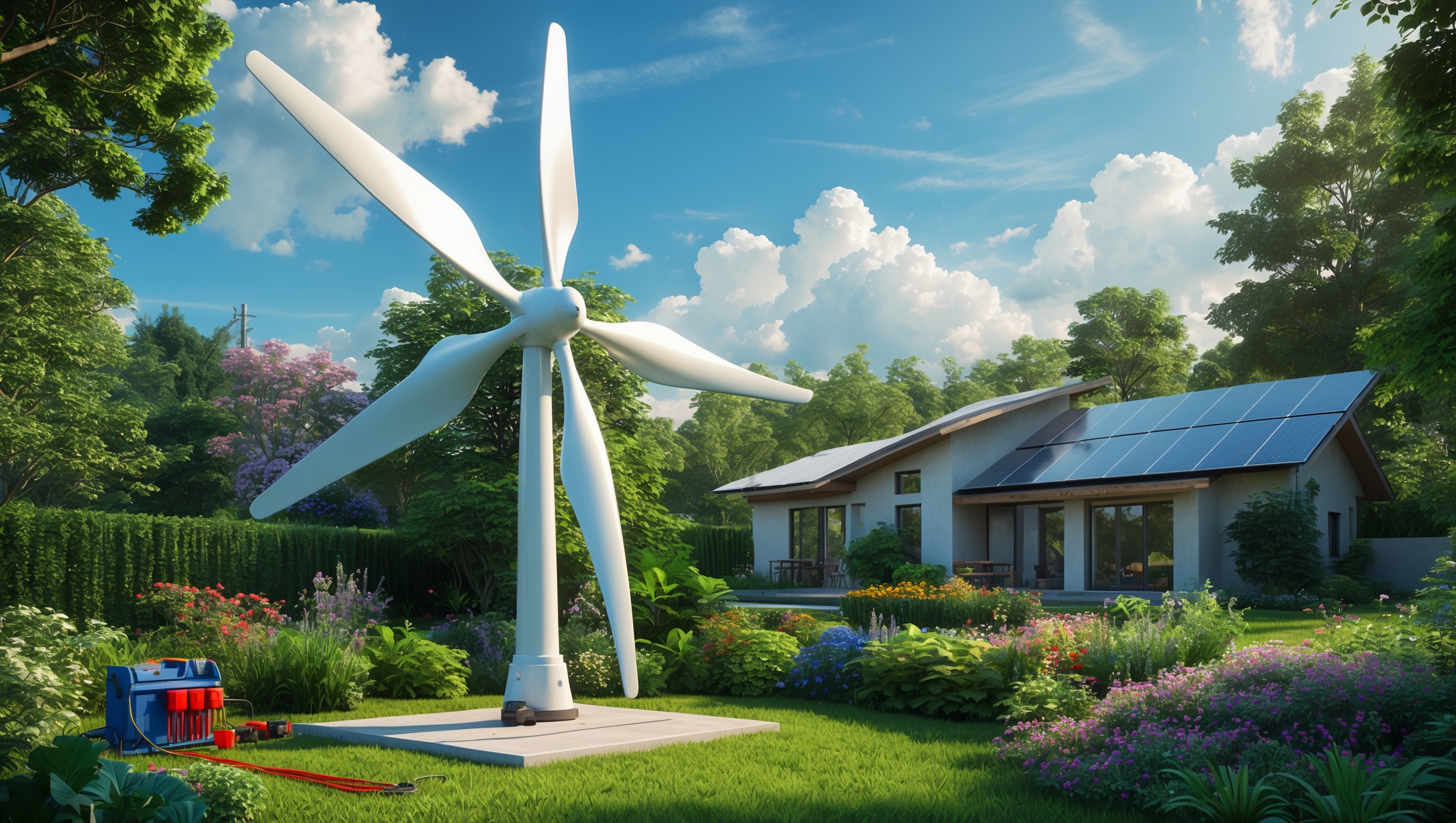Introduction: The Importance of Wind Turbine Maintenance for Sustainable Living
Home wind turbines are an increasingly popular choice for households seeking to reduce their carbon footprint and tap into renewable energy. As these systems become more accessible, many homeowners are installing small-scale turbines to supplement their power needs, lower utility bills, and contribute to a cleaner environment. However, simply installing a wind turbine isn’t the end of your journey—ongoing maintenance is essential to ensure your turbine operates safely, efficiently, and for as long as possible.
Neglecting routine care can lead to decreased energy output, unexpected breakdowns, and costly repairs, undermining your investment and sustainability goals. Conversely, a well-maintained turbine can reliably generate clean energy for decades. In this comprehensive guide, we’ll explore best practices for maintaining home wind turbine systems, from daily visual checks to annual overhauls. Whether you’re a new owner or an experienced DIY enthusiast, these practical strategies will help you maximize the return on your renewable energy investment, minimize downtime, and extend your system’s life—all while supporting a greener future.
Understanding Your Home Wind Turbine System
Key Components Requiring Maintenance
- Rotor Blades: Capture wind energy; vulnerable to physical wear and debris buildup.
- Nacelle: Houses gearbox, generator, and essential electronics.
- Yaw Mechanism: Rotates the turbine to face wind direction.
- Tower: Provides elevation; subject to weathering and structural stress.
- Electrical System: Includes wiring, inverter, and connection to battery or grid.
Typical Maintenance Challenges
- Environmental Exposure: Wind, rain, snow, and UV rays accelerate wear.
- Mechanical Stress: Continuous operation strains moving parts.
- Wildlife and Debris: Birds, insects, and airborne particles can cause damage or blockages.
Daily and Weekly Maintenance Tasks
Visual Inspections
Perform quick visual checks from the ground several times a week. Look for obvious signs of damage to the blades, unusual noises, vibrations, or wobbling from the nacelle or tower. Early detection of issues can prevent more serious problems.
- Check for oil leaks around the nacelle.
- Scan for bird nests or debris on blades or tower.
- Ensure the turbine is facing the wind and spinning freely when breezy.
Monitoring System Performance
Most modern home turbines have a monitoring system or app for real-time output data. Set up alerts for drops in performance, which can signal maintenance needs.
Monthly Maintenance Checklist
Tightening Bolts and Fasteners
Wind-induced vibration can gradually loosen bolts, especially at connection points (blade to hub, nacelle to tower, tower base). Use a torque wrench to check and tighten as needed, following manufacturer specifications.
Cleaning Blades and Sensors
- Use a long-handled brush or pressure washer to remove dirt, bird droppings, and bug residues from blades.
- Wipe down weather sensors, anemometers, and wind vanes to ensure accurate readings.
Checking Electrical Connections
- Inspect visible wiring for signs of fraying, corrosion, or animal damage.
- Ensure all connections in the junction box and inverter are secure.
Quarterly and Seasonal Maintenance Tasks
Lubricating Moving Parts
Apply appropriate lubricants to the yaw mechanism, bearings, and gearbox (if not sealed or maintenance-free). Use only lubricants recommended by the manufacturer to avoid compatibility issues.
Inspecting for Corrosion and Rust
- Check tower base, bolts, and metal surfaces for rust.
- Remove minor rust with a wire brush and apply anti-corrosion paint or coatings.
Testing Emergency Braking Systems
Activate and test the turbine’s braking system (manual or automatic) to ensure safe shutdown in high winds. This is especially important before stormy seasons.
Seasonal Adjustments
- Winter: Check for ice buildup or damage from freezing conditions; ensure blades spin freely.
- Spring: Clear springtime nest-building debris and pollen accumulations.
- Summer: Watch for insect nests or overheating concerns in the nacelle.
- Autumn: Remove leaves from moving parts and verify storm readiness.
Annual Maintenance: Deep Dive for Longevity
Blade and Hub Inspection
Once or twice a year, lower the turbine (if designed for tilt-down) or climb the tower using appropriate safety equipment. Closely inspect blades for cracks, chips, or warping. Small imperfections can drastically reduce efficiency and lead to catastrophic failure over time. Replace or repair blades as needed, balancing them to prevent vibration.
Nacelle and Gearbox Overhaul
Open the nacelle cover to inspect the generator, gearbox, and yaw mechanism. Look for oil leaks, gear wear, and overheating signs. Clean dust or debris from internal components and check for abnormal wear patterns.
Electrical System Testing
- Test inverter output for consistency and correct voltage.
- Check surge protection devices and replace if triggered.
- Verify integrity of grounding rods and lightning protection systems.
Structural Inspection
- Examine the entire tower for cracks, bending, or foundation settling.
- Check guy wires (if applicable) for tension and corrosion.
- Ensure all safety signage is visible and legible.
Updating Firmware and Monitoring Systems
If your turbine uses a digital controller or monitoring app, check for and install firmware updates. New software can optimize energy production and enhance safety features.
Troubleshooting Common Home Wind Turbine Problems
No Power or Low Output
- Check wind speed: Is there enough wind?
- Inspect blades for obstructions or damage.
- Test electrical connections for shorts or loose wires.
- Review inverter logs for error codes.
Unusual Noise or Vibration
- Listen for grinding or knocking, which may indicate bearing or gearbox issues.
- Inspect for loose bolts or misaligned blades.
- Shut down and investigate persistent issues before resuming operation.
Frequent Shutdowns or Braking
- Review system logs to identify high wind events or sensor malfunctions triggering shutdowns.
- Check braking system for wear or sticking mechanisms.
Corrosion or Water Ingress
- Ensure all seals on the nacelle and junction boxes are intact.
- Apply additional weatherproofing if necessary.
Essential Tools and Safety Gear for Wind Turbine Maintenance
- Torque wrench (for bolts and fasteners)
- Insulated screwdriver set
- Multimeter for electrical testing
- Long-handled brush or pressure washer
- Lubricants and anti-corrosion spray
- Binoculars (for ground-level inspections)
- Personal fall protection harness (for tower work)
- Helmet and safety gloves
- First aid kit
Pro Tips for Maximizing Turbine Lifespan and Output
- Keep a detailed maintenance log, recording inspections, issues, and repairs.
- Schedule major maintenance before stormy or high-wind seasons.
- Invest in a remote monitoring system for early detection of problems.
- Balance blades after any repair or replacement to prevent vibration.
- Consult your manufacturer’s manual for model-specific guidance.
- Join online forums or local renewable energy groups to share experiences and troubleshooting tips.
When to Call a Professional
While many maintenance tasks are safe for capable DIYers, some situations call for expert help. Call a certified technician to:
- Address electrical faults beyond basic wiring checks.
- Repair or replace gearboxes and generators.
- Perform tower straightening or significant structural repairs.
- Upgrade system components or software beyond your technical skills.
Remember: Safety always comes first. Never climb towers or disassemble nacelles without proper training and equipment.
Conclusion: Making Wind Power Work for You—Sustainably
Investing in a home wind turbine is a powerful step toward energy independence and environmental stewardship. However, achieving the full benefits of wind power demands more than a one-time installation—it requires a proactive and sustained maintenance effort. By implementing the best practices outlined in this guide, you can ensure your turbine operates at peak efficiency, safely generates clean energy, and stands the test of time against the elements.
Routine checks, timely repairs, and a focus on both mechanical and electrical health will not only prevent unexpected breakdowns but also maximize your return on investment. Whether you’re a hands-on homeowner or prefer to partner with professionals for major tasks, staying engaged with your turbine’s upkeep is essential to realizing the dream of sustainable, reliable, and cost-effective home energy.
As wind energy technology evolves, so do the tools and strategies for maintenance. Stay informed, stay safe, and take pride in your contribution to a cleaner, more resilient future. With the right care, your home wind turbine can be a cornerstone of sustainable living for decades to come.





Could you clarify what types of maintenance tasks a homeowner can realistically handle themselves versus those that should be left to a professional, especially when it comes to parts like the nacelle or electrical system?
Homeowners can typically handle visual inspections, cleaning the turbine blades, tightening accessible bolts, and clearing debris around the system. Tasks involving the nacelle, internal gears, or electrical system—such as wiring, inverter checks, or brake repairs—should be left to professionals, as these involve safety risks and technical expertise. If in doubt, always consult your turbine’s manual or the installer before attempting more complex maintenance.
The article mentions mechanical stress and environmental exposure as maintenance challenges. Are there certain brands or materials for rotor blades and towers that hold up better against harsh weather over time?
Yes, rotor blades made from fiberglass-reinforced composites or carbon fiber tend to resist weathering and fatigue better than plain plastics. For towers, galvanized steel and aluminum alloys are favored for their corrosion resistance and strength. Brands like Bergey and Primus Windpower are often noted for using these durable materials, which helps their systems withstand harsh climates and reduce long-term maintenance needs.
If my wind turbine suddenly stops producing power, should I check the electrical system first, or is it more likely related to mechanical stress on moving parts? Any troubleshooting steps for beginners would be helpful.
If your wind turbine stops producing power, start by checking the electrical system—look at fuses, breakers, and wiring connections, as these are common points of failure. If everything looks fine electrically, then inspect mechanical parts for signs of stress, wear, or obstructions. For beginners, ensure the blades can spin freely and listen for unusual noises. Always turn off the system before inspecting to stay safe.